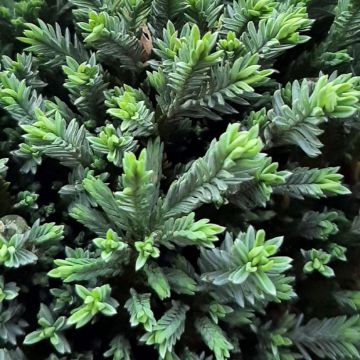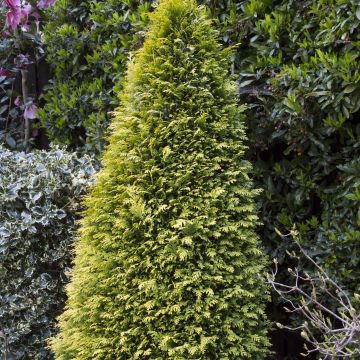

Chamaecyparis obtusa Lycopodioides - Hinoki Cypress
Chamaecyparis obtusa Lycopodioides - Hinoki Cypress
Chamaecyparis obtusa Lycopodioides
Hinoki Cypress, Japanese Cypress, Hinoki False Cypress
Special offer!
Receive a €20 voucher for any order over €90 (excluding delivery costs, credit notes, and plastic-free options)!
1- Add your favorite plants to your cart.
2- Once you have reached €90, confirm your order (you can even choose the delivery date!).
3- As soon as your order is shipped, you will receive an email containing your voucher code, valid for 3 months (90 days).
Your voucher is unique and can only be used once, for any order with a minimum value of €20, excluding delivery costs.
Can be combined with other current offers, non-divisible and non-refundable.
Home or relay delivery (depending on size and destination)
Schedule delivery date,
and select date in basket
This plant carries a 24 months recovery warranty
More information
We guarantee the quality of our plants for a full growing cycle, and will replace at our expense any plant that fails to recover under normal climatic and planting conditions.
Would this plant suit my garden?
Set up your Plantfit profile →
Description
Chamaecyparis obtusa 'Lycopodioides' is a variety of Japanese false cypress that is most unusual. Of modest stature and a beautiful dark green colour, it has a globose, irregular habit, and a curious growth, sometimes twisted, reminiscent of certain ferns called clubmosses. Its foliage is composed of round and dense scales, light green when young, emerging against a shiny green background. With its slow growth and small size, it is perfect for small gardens, rockeries, or large pots. It prefers moist, well-drained, neutral to acidic soils and dislikes hot and dry conditions as well as strong winds.
Also known as Hinoki cypress, and capable of reaching a height of 50m (164ft) in its natural environment, the false cypress is a large conifer of the cypress family. It is mainly used for making lacquered furniture and for the construction of numerous buildings such as palaces in its native Japan. This small-sized variety, 'Lycopodioides', with a globular habit, grows slowly. Reaching 1m (3ft 4in) in height after 10 years, it is a modest-sized conifer that will not exceed 3m (9ft 10in) in height and 1.50m (4ft 11in) in width. It develops branches of variable shape, randomly twisted or flattened. Its very fine branches are covered with non-prickly flattened needles.
Chamaecyparis obtusa 'Lycopodioides' is ideal for structuring a small urban garden or a flower bed. Due to its slow growth, it can be cultivated in a container or a large pot for several years. Its small Japanese silhouette will work wonders in a minimal setting, between large stones, and in a rockery. The architectural qualities of conifers naturally impose themselves in a contemporary garden. Mix together dwarf conifers with a columnar, pyramidal, or narrow conical habit. These plants provide lasting structure to a flower bed, mark pathways and border terraces. They serve as a backdrop for small ground cover roses, peonies, or tousled grasses with a very complementary form. They can also be associated with ground cover plants such as dwarf wormwoods and silver baskets, as well as small perennials. The key is to play with volumes and colours.
Tips: Water during periods of high heat, as it is sensitive to drought.
Report an error about the product description
Chamaecyparis obtusa Lycopodioides - Hinoki Cypress in pictures


Plant habit
Foliage
Botanical data
Chamaecyparis
obtusa
Lycopodioides
Cupressaceae
Hinoki Cypress, Japanese Cypress, Hinoki False Cypress
Southeast Asia
Other Chamaecyparis
View all →Planting and care
Chamaecyparis obtusa ''Lycopodioides' is best planted from September to November and from February to May in rich and deep, well-drained soil. Choose a partially shaded or gently sunny location sheltered from prevailing winds. Soak the root ball well before planting. Add organic fertilizer at planting and water generously in the first years. Apply a special conifer fertilizer every year in April and weed the soil in summer. It does not require pruning.
This variety has few soil requirements but tolerates limestone less well than its counterparts. It prefers deep, rich, soils and dislikes stagnant moisture in winter. Ensure good drainage of your soil. It appreciates moist and humid climates and does not tolerate dry conditions and prevailing winds. Although it tolerates shade it does best in a partially shaded or gently sunny area.
Planting period
Intended location
Care
This item has not been reviewed yet - be the first to leave a review about it.
Similar products
Haven't found what you were looking for?
Hardiness is the lowest winter temperature a plant can endure without suffering serious damage or even dying. However, hardiness is affected by location (a sheltered area, such as a patio), protection (winter cover) and soil type (hardiness is improved by well-drained soil).

Photo Sharing Terms & Conditions
In order to encourage gardeners to interact and share their experiences, Promesse de fleurs offers various media enabling content to be uploaded onto its Site - in particular via the ‘Photo sharing’ module.
The User agrees to refrain from:
- Posting any content that is illegal, prejudicial, insulting, racist, inciteful to hatred, revisionist, contrary to public decency, that infringes on privacy or on the privacy rights of third parties, in particular the publicity rights of persons and goods, intellectual property rights, or the right to privacy.
- Submitting content on behalf of a third party;
- Impersonate the identity of a third party and/or publish any personal information about a third party;
In general, the User undertakes to refrain from any unethical behaviour.
All Content (in particular text, comments, files, images, photos, videos, creative works, etc.), which may be subject to property or intellectual property rights, image or other private rights, shall remain the property of the User, subject to the limited rights granted by the terms of the licence granted by Promesse de fleurs as stated below. Users are at liberty to publish or not to publish such Content on the Site, notably via the ‘Photo Sharing’ facility, and accept that this Content shall be made public and freely accessible, notably on the Internet.
Users further acknowledge, undertake to have ,and guarantee that they hold all necessary rights and permissions to publish such material on the Site, in particular with regard to the legislation in force pertaining to any privacy, property, intellectual property, image, or contractual rights, or rights of any other nature. By publishing such Content on the Site, Users acknowledge accepting full liability as publishers of the Content within the meaning of the law, and grant Promesse de fleurs, free of charge, an inclusive, worldwide licence for the said Content for the entire duration of its publication, including all reproduction, representation, up/downloading, displaying, performing, transmission, and storage rights.
Users also grant permission for their name to be linked to the Content and accept that this link may not always be made available.
By engaging in posting material, Users consent to their Content becoming automatically accessible on the Internet, in particular on other sites and/or blogs and/or web pages of the Promesse de fleurs site, including in particular social pages and the Promesse de fleurs catalogue.
Users may secure the removal of entrusted content free of charge by issuing a simple request via our contact form.
The flowering period indicated on our website applies to countries and regions located in USDA zone 8 (France, the United Kingdom, Ireland, the Netherlands, etc.)
It will vary according to where you live:
- In zones 9 to 10 (Italy, Spain, Greece, etc.), flowering will occur about 2 to 4 weeks earlier.
- In zones 6 to 7 (Germany, Poland, Slovenia, and lower mountainous regions), flowering will be delayed by 2 to 3 weeks.
- In zone 5 (Central Europe, Scandinavia), blooming will be delayed by 3 to 5 weeks.
In temperate climates, pruning of spring-flowering shrubs (forsythia, spireas, etc.) should be done just after flowering.
Pruning of summer-flowering shrubs (Indian Lilac, Perovskia, etc.) can be done in winter or spring.
In cold regions as well as with frost-sensitive plants, avoid pruning too early when severe frosts may still occur.
The planting period indicated on our website applies to countries and regions located in USDA zone 8 (France, United Kingdom, Ireland, Netherlands).
It will vary according to where you live:
- In Mediterranean zones (Marseille, Madrid, Milan, etc.), autumn and winter are the best planting periods.
- In continental zones (Strasbourg, Munich, Vienna, etc.), delay planting by 2 to 3 weeks in spring and bring it forward by 2 to 4 weeks in autumn.
- In mountainous regions (the Alps, Pyrenees, Carpathians, etc.), it is best to plant in late spring (May-June) or late summer (August-September).
The harvesting period indicated on our website applies to countries and regions in USDA zone 8 (France, England, Ireland, the Netherlands).
In colder areas (Scandinavia, Poland, Austria...) fruit and vegetable harvests are likely to be delayed by 3-4 weeks.
In warmer areas (Italy, Spain, Greece, etc.), harvesting will probably take place earlier, depending on weather conditions.
The sowing periods indicated on our website apply to countries and regions within USDA Zone 8 (France, UK, Ireland, Netherlands).
In colder areas (Scandinavia, Poland, Austria...), delay any outdoor sowing by 3-4 weeks, or sow under glass.
In warmer climes (Italy, Spain, Greece, etc.), bring outdoor sowing forward by a few weeks.


















































